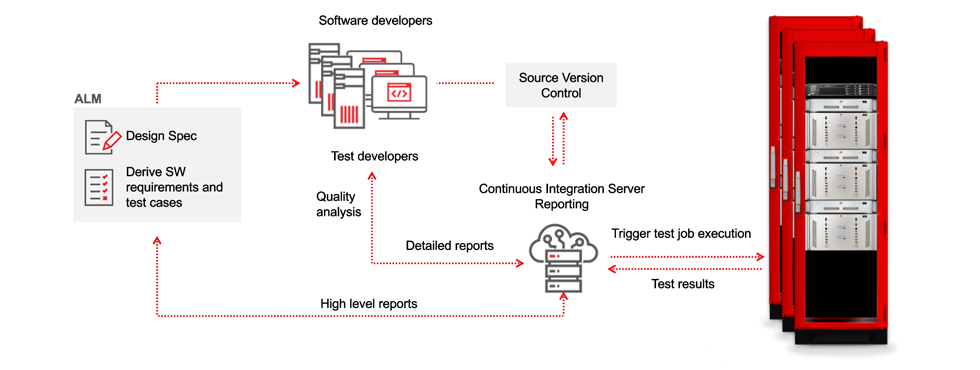Testing of power electronics is essential to ensure they meet safety, performance, and regulatory requirements, leading to reliable, high-quality, and competitive products that benefit both manufacturers and end-users. Automated testing in this setting is a particularly beneficial process which allows for quicker and more efficient execution of test cases compared to manual testing, which can be time-consuming and error prone.
Driven by growing control software complexity, product and performance integration specifications, and regulatory compliance – testing of power electronics has become even more intricate, expensive, and time consuming. Adding in resource constraints and the pressure to fulfill shorter development cycles, companies are hesitant to upgrade their processes and rely on custom legacy developed test automation solutions which limit accessibility to broader software testing ecosystems.

One point of concern when automating tests for power electronics is the ability to run safe tests automatically without human supervision. Controller Hardware-in-the-Loop (C-HIL), addresses that by removing the power stage out of the equation. Automating tests is a natural next step after adopting HIL, since you can safely run unsupervised tests.
The automated test scripts become an essential part of your product life-cycle maintenance. Because of that, it is important to pick a test framework which will speedup writing new tests and maintaining existing ones. Visualization of the results of said automated tests is key for speeding up the identification of issues and providing insight on the performance of the product. Having your test procedure in code format, makes it more flexible, easy to version control and inspect changes.
Typhoon HIL offers a suite of test automation products and services with specific focus to the testing and validation of power electronics and energy systems using HIL simulation platforms. Using our software tools and scripts to set up, control, and execute tests on the simulated hardware allows for more efficient and thorough testing processes. With TyphoonTest you can quickly write tests and generate a detailed report; With Typhoon Test Hub you can integrate these tests with the rest of your process and manage all the generated results.
- With our Python API, you have full control of the whole Typhoon tool chain, from updating device firmware or creating a model, to running a simulation and causing changes on the system.
- Enhance your test writing speed with our Pytest based test framework: TyphoonTest. Create custom scripts that define test scenarios, input conditions, and expected outputs for the HIL simulation. A detailed report will be automatically created.
- Easily manage all your test infrastructure and reports with Typhoon Test Hub. Bring visibility and insight on your test infrastructure; Get the most out thousands of test results.
- Invest human resources on adding value to the product, by means of new features. Repetitive tests should be automated, especially regression tests.
- Complete regression tests help identify unrelated (and undesirable) effects of changes. Run you tests often and fix bugs early.
- Integrate the HIL testing into a continuous integration and continuous delivery (CI/CD) pipeline, ensuring that new developments are thoroughly tested before deployment.
- Develop tailored test cases for specific customer needs, enabling efficient and reliable testing of their unique products or systems.
Fuel your teams with efficient, accurate, and scalable products – automate your testing with Typhoon HIL.
TyphoonTest Framework for Test Automation | Tutorial
How to easily create and run automatic tests for power electronics control testing? Learn about the TyphoonTest framework for test automation with a demo of a power tracking test.

